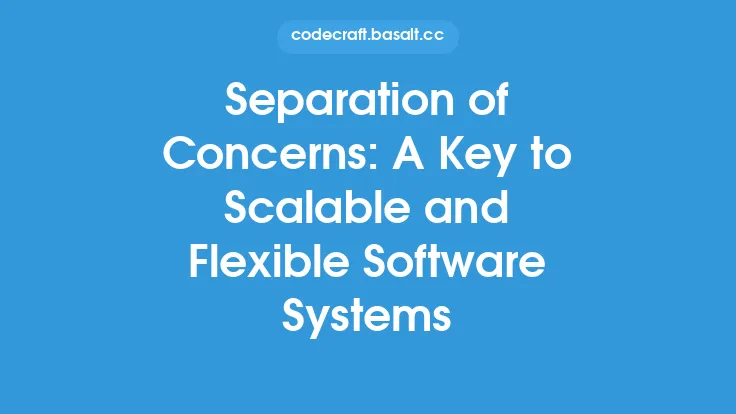When dealing with legacy systems, one of the most significant challenges is modernizing and refactoring the codebase to make it more maintainable, scalable, and efficient. Legacy systems often consist of tightly coupled, monolithic code that is difficult to modify and extend. However, by applying modular programming principles, it is possible to gradually refactor and modernize these systems, making them more adaptable to changing requirements and technologies.
Introduction to Modular Refactoring
Modular refactoring involves breaking down a large, complex system into smaller, independent modules that can be developed, tested, and maintained separately. This approach allows developers to focus on specific components of the system, making it easier to identify and address technical debt, improve code quality, and reduce the risk of introducing new bugs. By refactoring legacy code into modular components, developers can also take advantage of modern programming languages, frameworks, and tools, making it easier to integrate new features and technologies into the system.
Assessing the Legacy System
Before starting the refactoring process, it is essential to assess the legacy system and identify areas that require the most attention. This involves analyzing the system's architecture, code structure, and dependencies to determine the best approach for modularization. Developers should look for components that are tightly coupled, have high cohesion, or are prone to changes, as these are likely to be the most challenging to refactor. Additionally, identifying areas with high technical debt, such as outdated libraries or deprecated code, can help prioritize the refactoring effort.
Creating a Modular Architecture
To create a modular architecture, developers need to identify the key components and services that make up the legacy system. This involves decomposing the monolithic codebase into smaller, independent modules that can be developed and maintained separately. Each module should have a clear and well-defined interface, making it easier to integrate with other components and services. By using interfaces and dependency injection, developers can reduce coupling between modules, making it easier to modify and extend the system without introducing new bugs.
Refactoring Strategies
There are several refactoring strategies that can be applied to legacy systems, including:
- Extract Class: Extracting a new class from an existing one to reduce complexity and improve cohesion.
- Extract Method: Extracting a new method from an existing one to improve code readability and reusability.
- Replace Conditional with Polymorphism: Replacing conditional statements with polymorphic code to improve flexibility and maintainability.
- Introduce Foreign Method: Introducing a new method to an existing class to improve code reusability and reduce coupling.
By applying these refactoring strategies, developers can gradually transform the legacy system into a more modular and maintainable architecture.
Managing Dependencies
Managing dependencies is critical when refactoring a legacy system. This involves identifying and isolating dependencies between modules, making it easier to modify and extend the system without introducing new bugs. By using dependency injection and interfaces, developers can reduce coupling between modules, making it easier to test and maintain the system. Additionally, using tools such as dependency graphs and visualization tools can help identify and manage dependencies, making it easier to refactor the system.
Testing and Validation
Testing and validation are essential when refactoring a legacy system. This involves creating a comprehensive set of unit tests, integration tests, and system tests to ensure that the refactored code meets the required functionality and performance standards. By using testing frameworks and tools, developers can automate the testing process, making it easier to identify and fix bugs. Additionally, using continuous integration and continuous deployment (CI/CD) pipelines can help ensure that the refactored code is properly tested and validated before it is deployed to production.
Gradual Refactoring
Gradual refactoring involves refactoring the legacy system in small, incremental steps, rather than trying to refactor the entire system at once. This approach allows developers to focus on specific components of the system, making it easier to identify and address technical debt, improve code quality, and reduce the risk of introducing new bugs. By refactoring the system gradually, developers can also take advantage of modern programming languages, frameworks, and tools, making it easier to integrate new features and technologies into the system.
Best Practices
When refactoring a legacy system, there are several best practices that should be followed, including:
- Keep it Simple: Keeping the refactored code simple and easy to understand, making it easier to maintain and extend.
- Test-Driven Development: Using test-driven development (TDD) to ensure that the refactored code meets the required functionality and performance standards.
- Continuous Integration: Using continuous integration (CI) to automate the testing and validation process, making it easier to identify and fix bugs.
- Code Reviews: Performing regular code reviews to ensure that the refactored code meets the required coding standards and best practices.
By following these best practices, developers can ensure that the refactored legacy system is maintainable, scalable, and efficient, making it easier to adapt to changing requirements and technologies.
Conclusion
Refactoring a legacy system using modular programming principles can be a challenging but rewarding task. By assessing the legacy system, creating a modular architecture, applying refactoring strategies, managing dependencies, testing and validating the code, and following best practices, developers can gradually transform the legacy system into a more maintainable, scalable, and efficient architecture. This approach allows developers to take advantage of modern programming languages, frameworks, and tools, making it easier to integrate new features and technologies into the system. By applying modular programming principles to legacy systems, developers can ensure that the system remains relevant and adaptable to changing requirements and technologies, making it a valuable asset to the organization.





